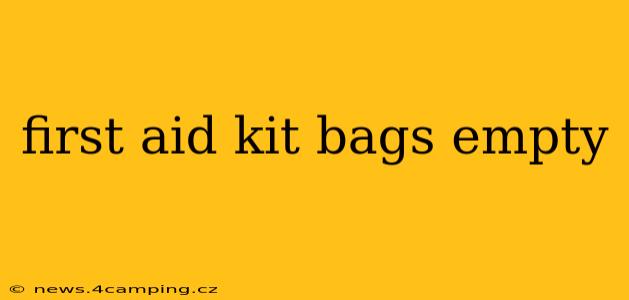Are you prepared for unexpected injuries or illnesses? Having a well-stocked first aid kit is crucial, but even the best kit is useless if it's not readily accessible and properly organized. This guide delves into the importance of having empty first aid kit bags ready to personalize and the factors to consider when selecting and equipping them.
Why Choose an Empty First Aid Kit Bag?
Pre-assembled first aid kits often contain items you may never need, while missing essentials specific to your needs. An empty first aid kit bag provides the flexibility to:
- Customize your kit: Tailor your contents to the specific needs of your environment, activities, and individuals (e.g., family, workplace, hiking trips). This ensures you have exactly what you need, when you need it.
- Control quality and expiry dates: You can choose high-quality supplies and check expiry dates regularly, avoiding the risk of using expired medications or bandages.
- Maintain freshness: Properly storing medications and supplies in a clean, dry environment is essential for maintaining their effectiveness. An empty bag allows for better organization and control.
- Save money: Building your own kit can be more cost-effective than buying pre-assembled kits, especially for larger or more specialized needs.
- Choose the right size and style: You can select a bag size and style that best suits your needs, whether it's a compact travel kit or a larger, more comprehensive kit for home or a workplace.
What to Consider When Choosing an Empty First Aid Kit Bag?
Selecting the right empty bag is crucial. Consider these factors:
- Size and Capacity: How much space do you need? A small bag is perfect for travel, while a larger bag is suitable for home or workplace use.
- Material: Durable, water-resistant materials like nylon or ripstop fabric are ideal for protecting your supplies.
- Organization: Look for bags with compartments, pockets, or dividers to keep supplies organized and easily accessible. Clear pockets can help you quickly identify contents.
- Accessibility: Ensure the bag is easy to open and close, especially in emergency situations. Zippers or strong closures are essential.
- Portability: If you plan to carry the kit, consider its weight and whether it has a comfortable carrying handle or strap.
What Should You Put in Your Empty First Aid Kit Bag? (A Basic Guide)
The specific contents of your kit will depend on your needs, but here are some essential items:
- Wound care: Bandages (various sizes), antiseptic wipes, gauze pads, adhesive tape, sterile gloves.
- Pain relief: Pain relievers (ibuprofen, acetaminophen – check for allergies!), and any personal prescription medications.
- Burn treatment: Burn cream or gel.
- Allergy treatment: Antihistamines (if needed).
- First aid instructions: A small printed guide to basic first aid techniques.
How Often Should You Check and Restock Your First Aid Kit?
Regularly checking and restocking your kit is crucial to ensure that it's always prepared for emergencies. Aim to inspect your kit at least every six months, replacing any expired or used items.
What are the different types of first aid kits available?
Several first aid kit types cater to various needs. These range from small, travel-sized kits to larger, comprehensive kits designed for home, workplaces, or vehicles. The best type depends entirely on your specific requirements and environment. Remember, customization is key with empty first aid kit bags.
Where can I find empty first aid kit bags?
Empty first aid kit bags are widely available from various retailers, both online and in physical stores. Pharmacies, sporting goods stores, and online marketplaces offer a wide selection of bags, ensuring you find one that perfectly matches your needs and preferences.
By selecting an appropriate empty bag and carefully curating its contents, you'll have a personalized and effective first aid kit ready for any eventuality. Remember, being prepared is the first step to effective emergency response.
